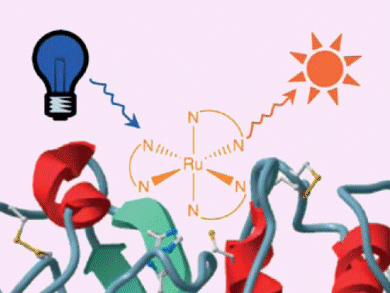Enzyme functionalization with metal complexes is a highly active area of research in bioinorganic chemistry. Michèle Salmain and colleagues of the CNRS (Centre national de la recherche scientifique), France, report new ruthenium diimine complexes with a maleimide moiety. The complexes displayed noticeable luminescence, with an emission wavelength at 600 nm that originated from a metal-to-ligand charge-transfer triplet state.
Owing to the specific reactivity of the maleimide to thiols, the complexes were reacted with the cysteine endoproteinase papain. The bioconjugates showed enhanced luminescence, demonstrating that they can be used as biological labeling reagents for biomolecules. These results will be useful for the development of new luminescent inorganic or organometallic complexes as biological probes.
- Synthesis, Characterization and Luminescence Properties of Dipyridin-2-ylamine Ligands and Their Bis(2,2′-bipyridyl)ruthenium(II) Complexes and Labelling Studies of Papain from Carica papaya
P. Haquette, J. Jacques, S. Dagorne, C. Fosse, M. Salmain,
Eur. J. Inorg. Chem. 2010.
DOI: 10.1002/ejic.201000585




